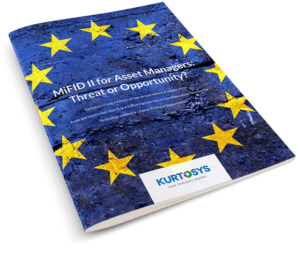Time is running out for asset managers planning how they will comply with the MiFID II and PRIIPs regulations that come into force next year. And given the work involved with getting processes and documentation in shape for the new regimes – not to mention the considerable overlap between MiFID II and PRIIPs – managers could be forgiven for regarding compliance as an unwanted distraction from the day job of growing their businesses.
However, understandable though such an attitude might be, it’s the wrong approach on this occasion. Not because there aren’t genuine question marks over whether these reforms will genuinely deliver improved outcomes for consumers – that’s by no means a certainty – but because the new regulation brings with it an important opportunity.
To see why, consider the conclusions of research recently conducted by Money Marketing magazine, which asked a large group of financial advisers for their views about the key investor information documents (KIIDs) and fund factsheets published by asset managers. The consensus amongst these advisers was twofold: first that these documents don’t currently provide them with all the information they need from asset managers; and, second, that the requirements of the MiFID II and PRIIPs regulation provide a golden opportunity to do better.
To put that a different way, asset managers need to think about more than simple compliance with the new rules as they redesign their KIIDs to meet the requirements of MiFID II and PRIIPs. The additional challenge is to deliver documentation that actually adds value – literature that financial advisers and other intermediaries, as well as individual investors, find useful.
If they can pull off that trick, the effort and expense of regulatory compliance need not be written off as an unwanted but necessary business cost; rather, asset managers could look at it as an investment in sales and marketing on which a positive return might be earned.
What, then, are advisers looking for from KIIDs that they’re not currently getting? Money Marketing’s research suggests many advisers object to the generic nature of the information contained in fund literature – typically standardised performance statistics and some generalised market commentary. Instead, they want much greater detail on performance attribution, setting out what “alpha” the asset manager has added to the returns delivered by the market. This might, by the way, also be a crucial weapon in the battle against passive investment management, which continues to take market share from active managers.
Other advisers call for more portfolio detail. Fixed-income fund managers, they suggest, too often provide just a simple list of holdings; what advisers actually want is detailed data on credit rating breakdowns, maturity yields, durations and so on. Similarly, property funds are notorious for providing limited data, rarely setting out detail on cash balances, the type of properties held, rental yields and lease length.
There are exceptions to the rule. In Money Marketing’s research, Woodfood Investment Management, TwentyFour Asset Management and Kames Capital all won plaudits for offering KIIDs and other fund documentation that delivers a value-adding service to intermediaries.
On the other hand, some asset managers appear not even to be managing the basics. One in 10 advisers in the research complained that factsheets didn’t even manage to explain funds’ investment objectives clearly. Many complained that asset managers often provide little explanation of how those objectives will be achieved, beyond standardised and impenetrable language around the type of assets in which they will invest.
Clearly, many asset managers need to do considerably better. Half of all financial advisers say they depend on managers’ marketing materials to some extent in order to reach a judgement on their funds. Many also rely on this literature to form the basis of discussions with clients. So where literature is of a poor quality, asset managers’ sales are likely to suffer.
It may be that this documentation has sometimes been an afterthought for asset managers – or that literature was designed and written some time ago and never updated. Now, however, the regulatory imperative is that all managers will need to think about their documentation, simply to ensure it meets the minimum requirements before MiFID II and PRIIPs come into force next year. Surely this is the moment to ensure KIIDs and other fund materials have a marketing value that works to your advantage, rather than simply representing a compliance expense. The regulation sets out certain changes that asset managers must make, but there is an opportunity to do much more.
White Paper: MiFID II for Asset Managers: Threat or Opportunity?
 The European Union (EU) MiFID II regulations, which come into effect in January 2018, will have a huge impact on the asset management industry. But many managers do not yet have the technological solutions to comply and thrive in the new regime and software providers expect a capacity crunch as investment houses rush to prepare. We look at some of the issues and opportunities.
The European Union (EU) MiFID II regulations, which come into effect in January 2018, will have a huge impact on the asset management industry. But many managers do not yet have the technological solutions to comply and thrive in the new regime and software providers expect a capacity crunch as investment houses rush to prepare. We look at some of the issues and opportunities.



